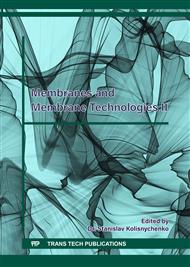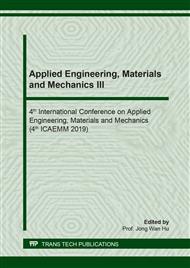[1]
M. Goswami, A. M. Das, Synthesis and characterization of a biodegradable cellulose acetate montmorillonite composite for effective adsorption of eosin Y, Carbohydr. Polym. 206 (2019) 863-872.
DOI: 10.1016/j.carbpol.2018.11.040
Google Scholar
[2]
J. Li, L. P. Zhang, F. Peng, J. Bian, T. Q. Yuan, F. Xu, Microwave-assisted solvent-free acetylation of cellulose with acetic anhydride in the presence of iodine as a catalyst, Molecules. 14(9) (2009) 3551-3566.
DOI: 10.3390/molecules14093551
Google Scholar
[3]
D. G. Yu, X. Y. Li, X. Wang, W. Chian, Y. Z. Liao, Y. Li, Zero-order drug release cellulose acetate nanofibers prepared using coaxial electrospinning, Cellulose, 20(1) (2013) 379-389.
DOI: 10.1007/s10570-012-9824-z
Google Scholar
[4]
D. A. Cerqueira, G. R. Filho, C. S. Meireles, Optimization of sugarcane bagasse cellulose acetylation, Carbohydr. Polyme. 69(3) (2007) 579-582.
DOI: 10.1016/j.carbpol.2007.01.010
Google Scholar
[5]
A. EL-Gendi, S. S. Ali, S. A. Ahmed, H. A. Talaat, Development of membrane blend using casting technique for water desalination, Membr. Water. Treat. 3(3) (2012) 201-209.
DOI: 10.12989/mwt.2012.3.3.201
Google Scholar
[6]
J. A. L. Ramrez, M. D. Oviedo, J. M. Alonso, Comparative studies of reverse osmosis membranes for wastewater reclamation, Desalination, 191(1-3) (2006) 137-147.
DOI: 10.1016/j.desal.2005.08.013
Google Scholar
[7]
S. Ehsan, M. Toraj, Cellulose acetate (CA)/polyvinylpyrrolidone (PVP) blend asymmetric membranes: preparation, morphology and performance, Desalination, 249(2) (2009) 850-854.
DOI: 10.1016/j.desal.2008.12.066
Google Scholar
[8]
L. Yu, K. Deana, L. Lin, Polymer blends and composites from renewable resources, Prog. Polym. Sci. 31(6) (2006) 576-602.
Google Scholar
[9]
A. V. R. Reddya, H. R. Patelb, Chemically treated polyethersulfone/polyacrylonitrileblend ultrafiltration membranes for better fouling resistance,Desalination, 221(1-3) (2008) 318-323.
DOI: 10.1016/j.desal.2007.01.089
Google Scholar
[10]
S. M. Ibrahim, H. Nagasawa, M. Kanezashi, T. Tsuru, Robust organosilicamembranes for high temperature reverse osmosis (RO) application: membranepreparation,separation characteristics of solutes and membraneregeneration, J. Membr. Sci. 493 (2015) 515-523.
DOI: 10.1016/j.memsci.2015.06.060
Google Scholar
[11]
Y. Zhao, C. Qiu, X. Li, A. Vararattanavech, W. Shen, J. Torres, C. H_elix-Nielsen, R. Wang, X. Hu, A. G. Fane, C. Y. Tang, Synthesis of robust andhigh-performance aquaporin-based biomimetic membranes by interfacialpolymerization-membranepreparation and RO performance characterization, J. Membr. Sci. 423-424 (2012) 422-428.
DOI: 10.1016/j.memsci.2012.08.039
Google Scholar
[12]
F. A. Ugbe, V. A. Ikudayis, The kinetics of eosin yellow removal from aqueous solution using pineapple peels, Edorium J. Waste Manag. 2 (2017) 5-11.
DOI: 10.5348/w01-2017-6-oa-2
Google Scholar
[13]
S. Chatterjee, S. Chatterjee, B. P. Chatterjee, A. R. Das, A. K. Guha, Adsorption of a model anionic dye, eosin Y, from aqueous solution by chitosan hydrobeads, J. Colloid Interface Sci. 288(1) (2005) 30-35.
DOI: 10.1016/j.jcis.2005.02.055
Google Scholar
[14]
E. O. Oyelude, J. A. M. Awudza, S. K. Twumasi, Equilibrium, kinetic and thermodynamic study of removal of eosin yellow from aqueous solution using teak leaf litter powder, Sci. Rep. 7 (2017).
DOI: 10.1038/s41598-017-12424-1
Google Scholar
[15]
T. Riaz, A. Ahmad, S. Saleemi, M. Adrees, F. Jamshed, A. M. Hai, T. Jamil, Synthesis and characterization of polyurethane-cellulose acetateblend membrane for chromium (VI) removal, Carbohyd. Polym. 153 (2016) 582-591.
DOI: 10.1016/j.carbpol.2016.08.011
Google Scholar
[16]
Isroi, A. Cifriadi, T. Panji, N. A. Wibowo, K. Syamsu, Bioplastic production from cellulose of oil palm empty fruit bunch, IOP Conf. Series: Earth Envirom. Sci. 65(1) (2017).
DOI: 10.1088/1755-1315/65/1/012011
Google Scholar



